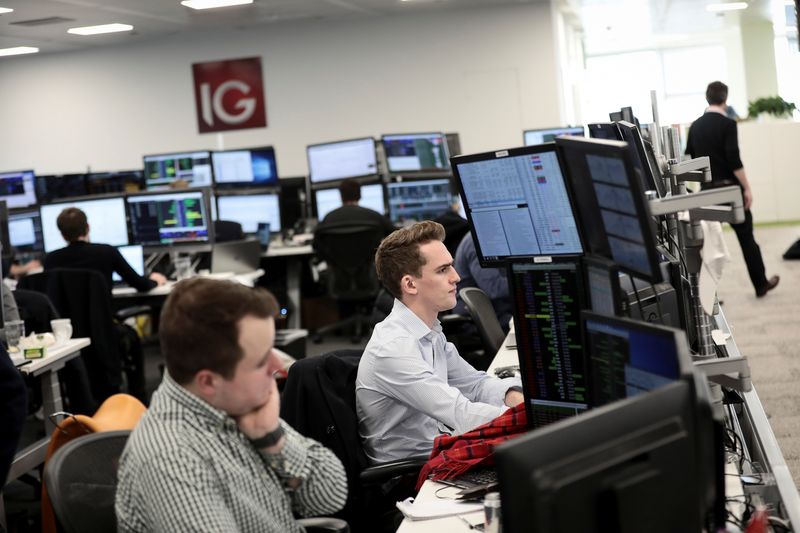By Marc Jones
LONDON (Reuters) - World stock markets began the new year with a shot of Chinese stimulus, ensuring there was no immediate hangover after the wild gains of 2019.
News that China's central bank was freeing another 800 billion yuan ($115 billion) for its economy came after U.S. President Donald Trump tweeted on Tuesday that a long-awaited trade pact with Beijing would be signed on Jan 15.
The double lift saw Europe's main markets jump 0.8% to 1.3%, outpacing Asia's overnight gains and putting them on course for their best opening session of a year since 2013.
MSCI's broadest index of world shares added 0.2% to its 24% 2019 surge, which was the fourth best of all time. Higher U.S. futures suggested solid gains on Wall Street too, with S&P 500 e-minis up 0.5%.
"Over a longer-term horizon, we believe global stocks have greater performance potential than global bonds, supported by continued growth and moderate inflation," Franklin Templeton said in its 2020 outlook, although it stressed it remained cautious for now.
An upward revision to some otherwise gloomy euro zone manufacturing PMI data pushed inflation expectations higher. Germany's 15-year bond yield briefly turned positive for the first time since July.
Bond yields tend to drive borrowing costs in the wider economy and their drop last year, as the Federal Reserve, European Central Bank and dozens of other central banks around the world cut interest rates, helped limit an economic slowdown.
"Although firms grew somewhat more optimistic about the year ahead, a return to growth remains a long way off," said Chris Williamson, chief business economist at IHS Markit, which compiles the purchasing manager indices.
NEW YEAR, NEW GEAR?
In currency markets, the dollar scored its biggest rise against major peers since early November with a 0.33% gain.
That snapped a six-day losing streak and pushed the euro off five-month highs, though it was in thin trading and followed a 0.4% drop on New Year's Eve, once it became clear there would be no year-end repeat of September's U.S. money market turbulence.
Sterling dropped to $1.32 and the euro fell back under $1.12. The Aussie and Kiwi dollars took hits and the Japanese yen was little changed at 108.81 per dollar.
After the stimulus shot in Beijing, China's yuan closed at 6.9631, its strongest finish against the dollar since Aug. 2. The offshore yuan also gained after an initial downward move.
The stimulus -- a cut in banks' reserve requirements -- had been expected before January's Lunar New Year holidays and after Premier Li Keqiang's pledge last month to provide more stimulus.
"At the end of last year the dollar sold off quite sharply, so we are seeing an easing in some of the dollar selling pressure," said Lee Hardman, senior FX strategist at MUFG.
"The liquidity squeeze didn't materialise so that's contributing to stability in broader financial markets ... But the dollar story has been turning negative in recent months, partly because of action taken by the Fed to ease dollar liquidity," Hardman said, referring to the U.S. central bank's balance sheet expansion re-launched in October.
China's blue-chip CSI300 index, one of the world's best performers last year, rose 1.4%, reaching its highest since Feb. 7, 2018. Hong Kong's Hang Seng added 1.25%.
Oil prices rose as tensions in the Middle East fuelled worries about supply. The U.S. military carried out air strikes against an Iran-backed militia this past weekend. Consequently, protesters stormed the U.S. Embassy in Baghdad on Wednesday, then withdrew after the United States deployed extra troops.
U.S. crude was up as much as 0.3% to $61.28 and global benchmark Brent crude rose 0.2% to $66.15 per barrel, building on a rise that gave oil markets their biggest annual gain in three years in 2019.
Gold, which had benefited from a weaker dollar, was up 0.4% on the spot market despite the U.S. currency's gains. It last fetched $1,523 per ounce while China-sensitive industrial metal copper climbed towards an eight-month high.

($1 = 6.9633 Chinese yuan renminbi)